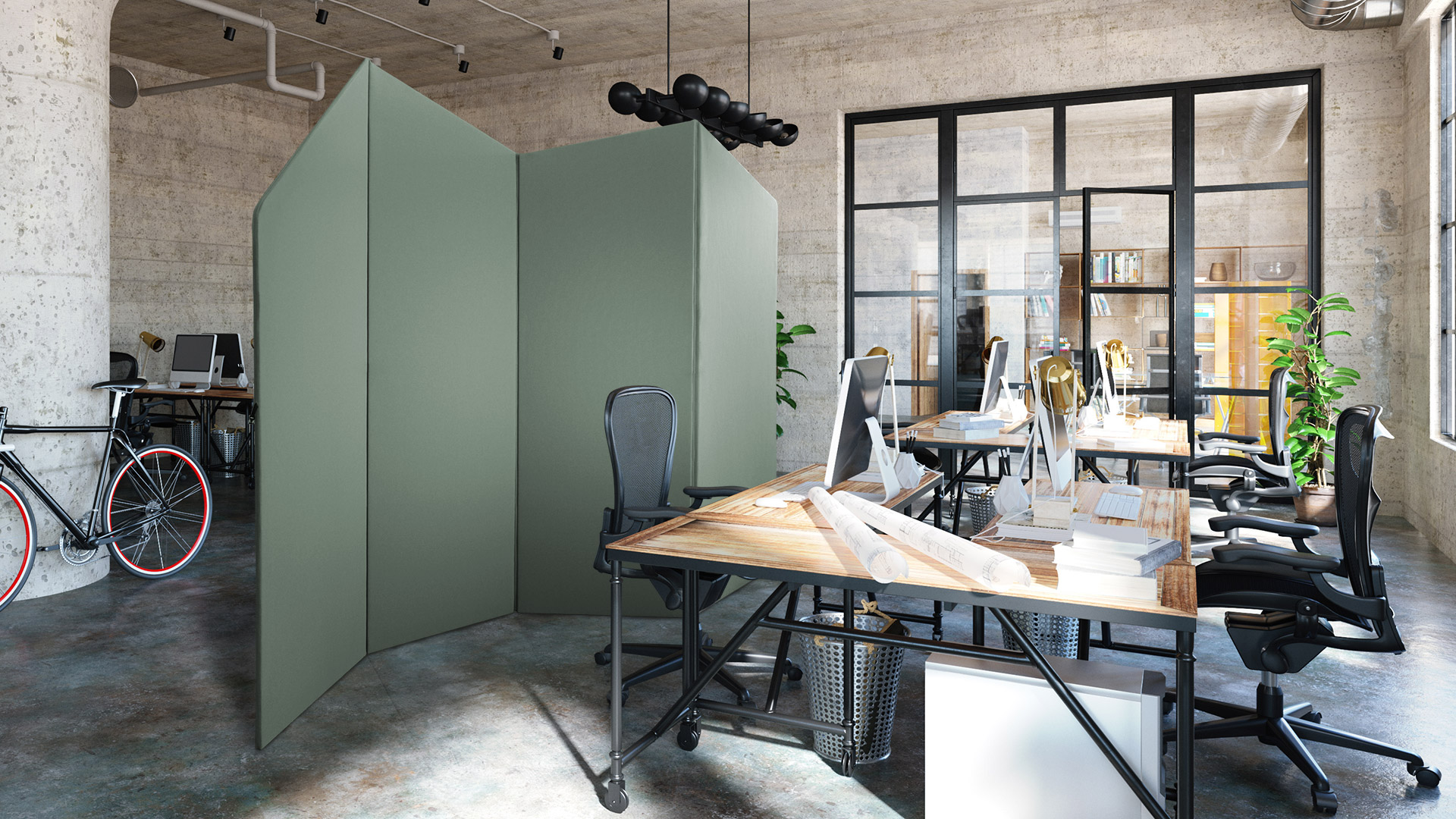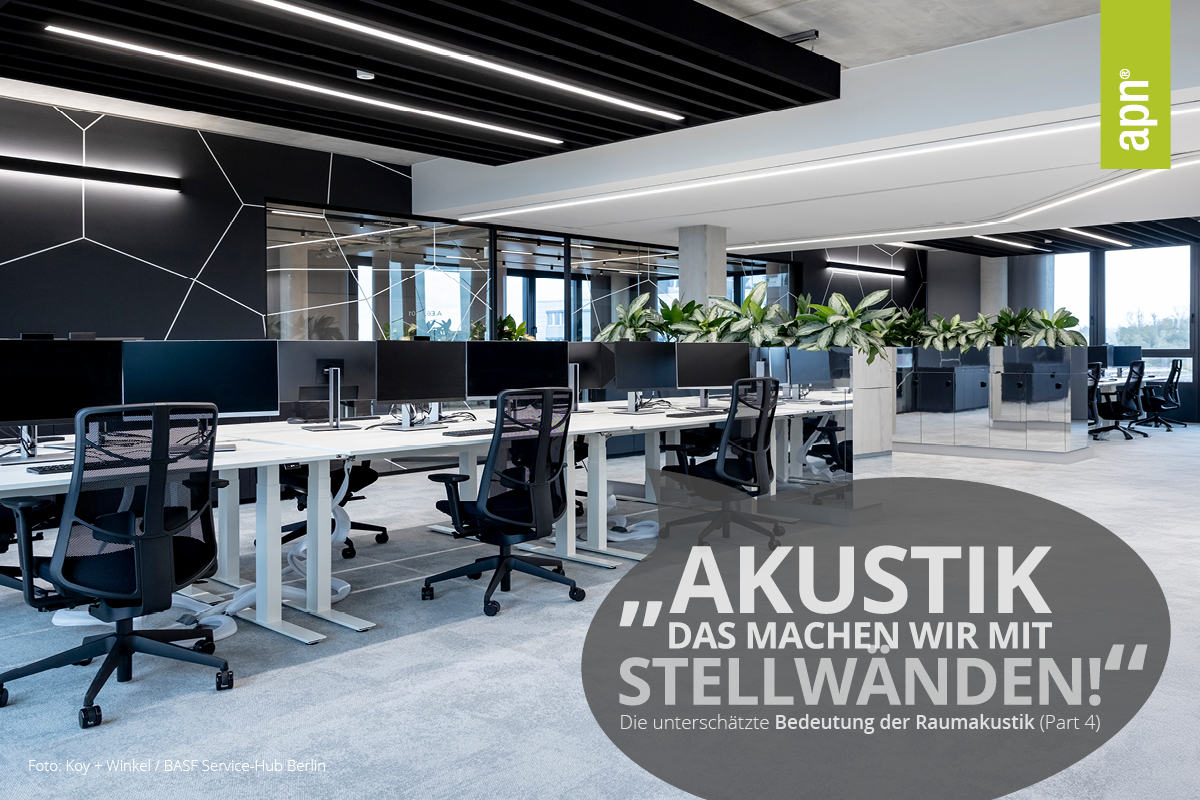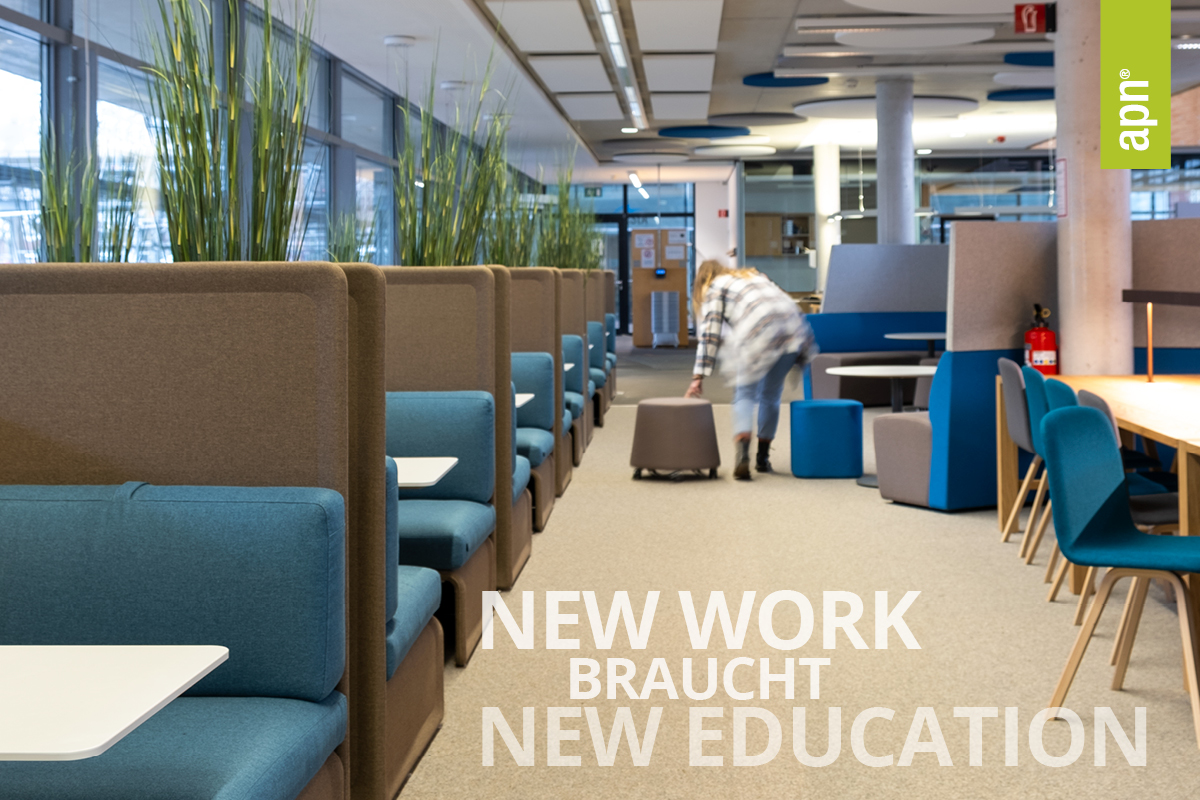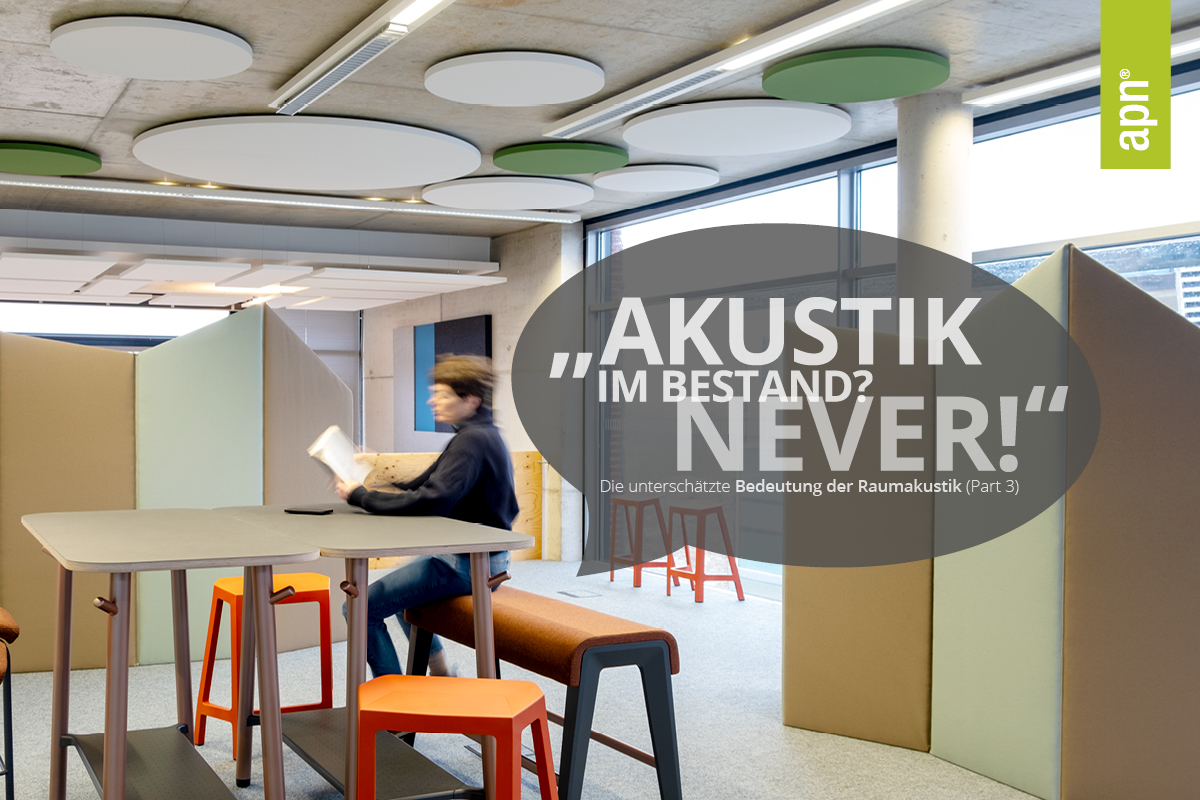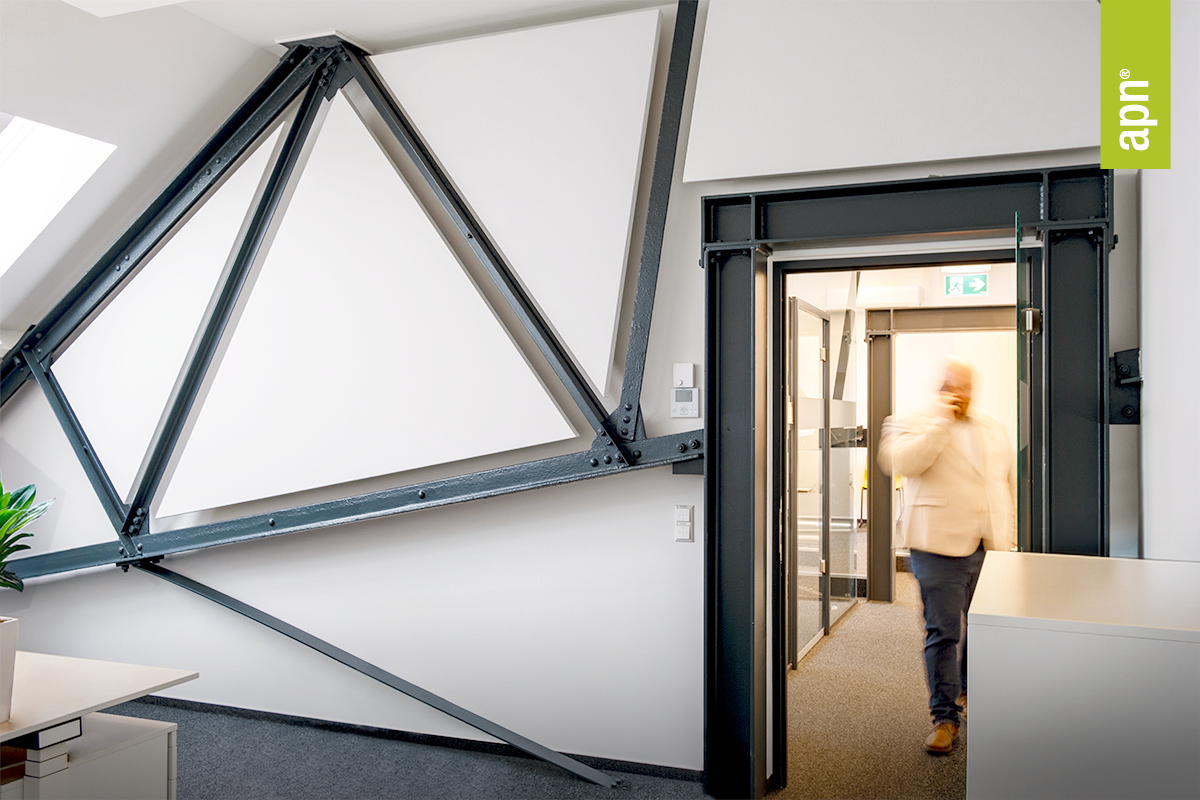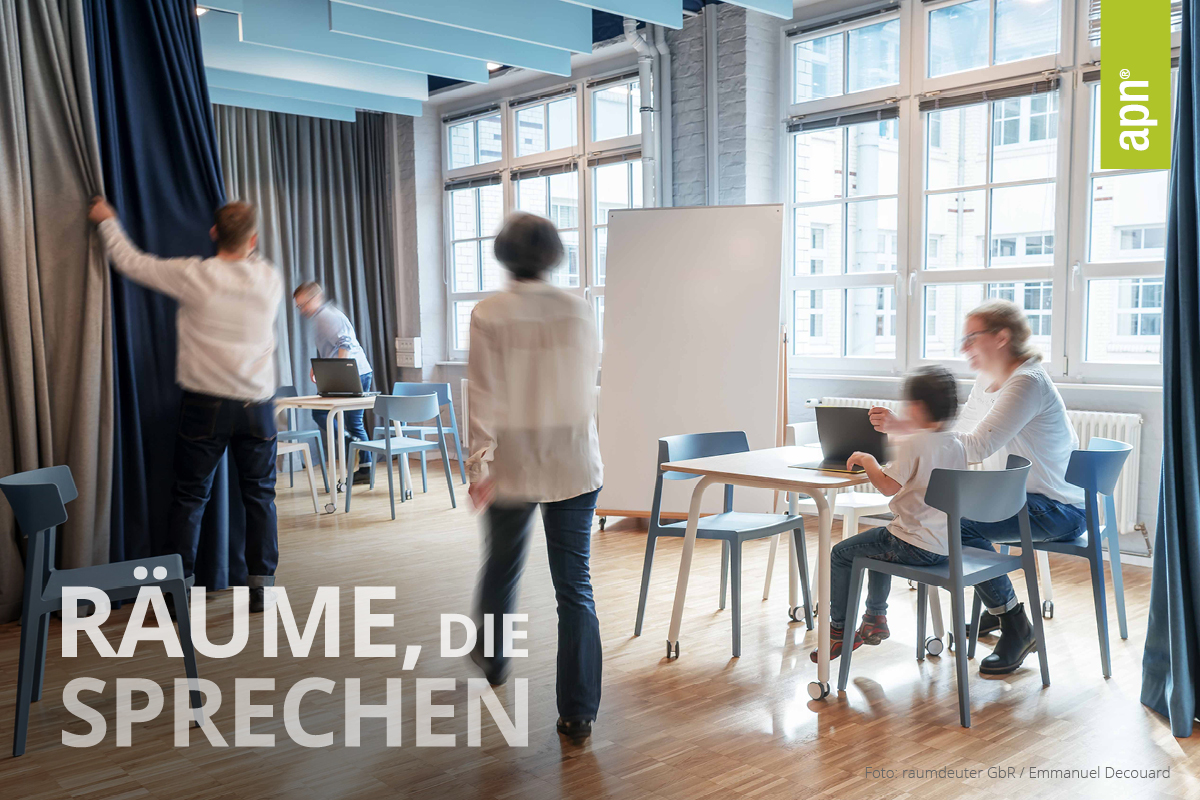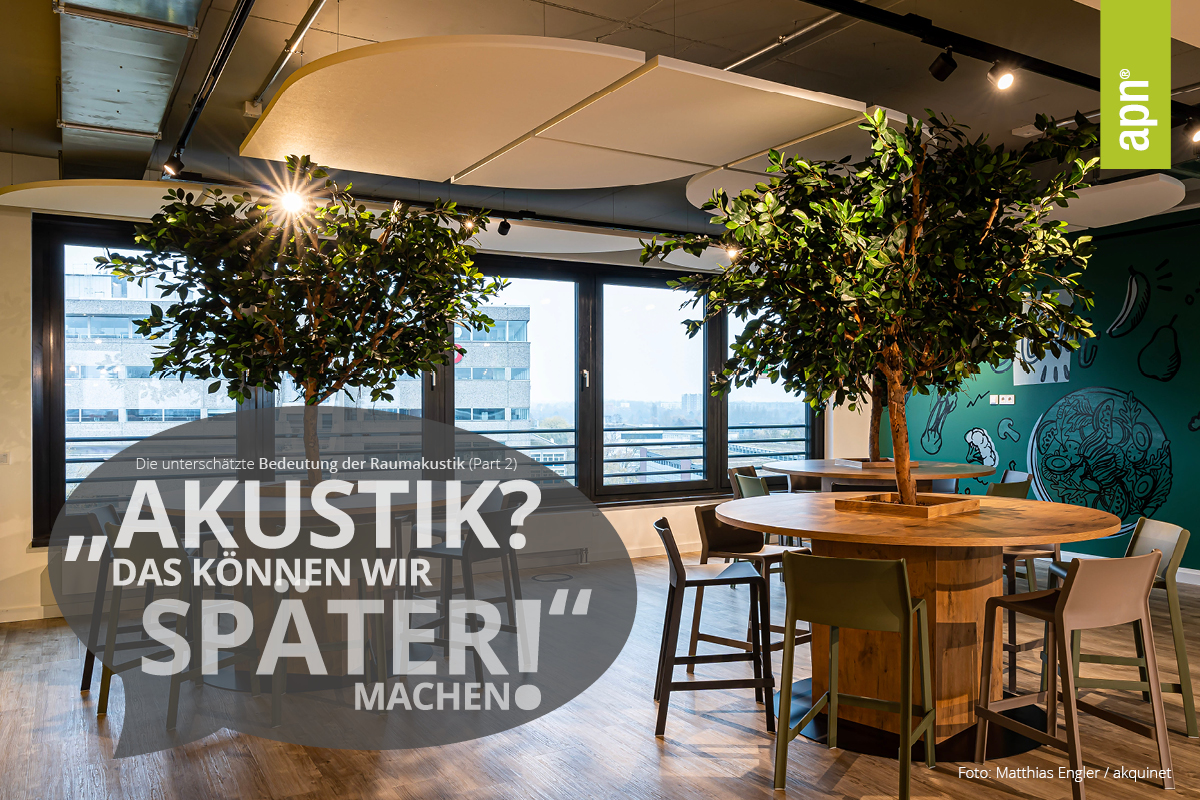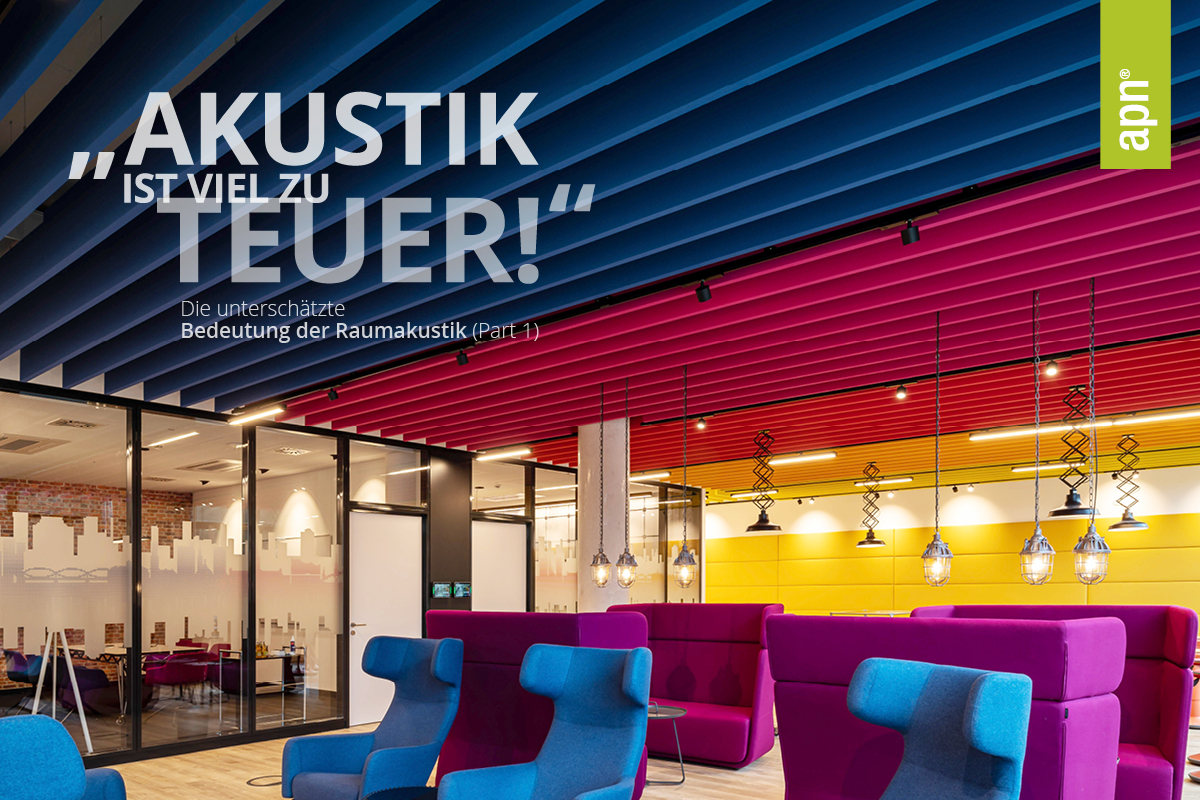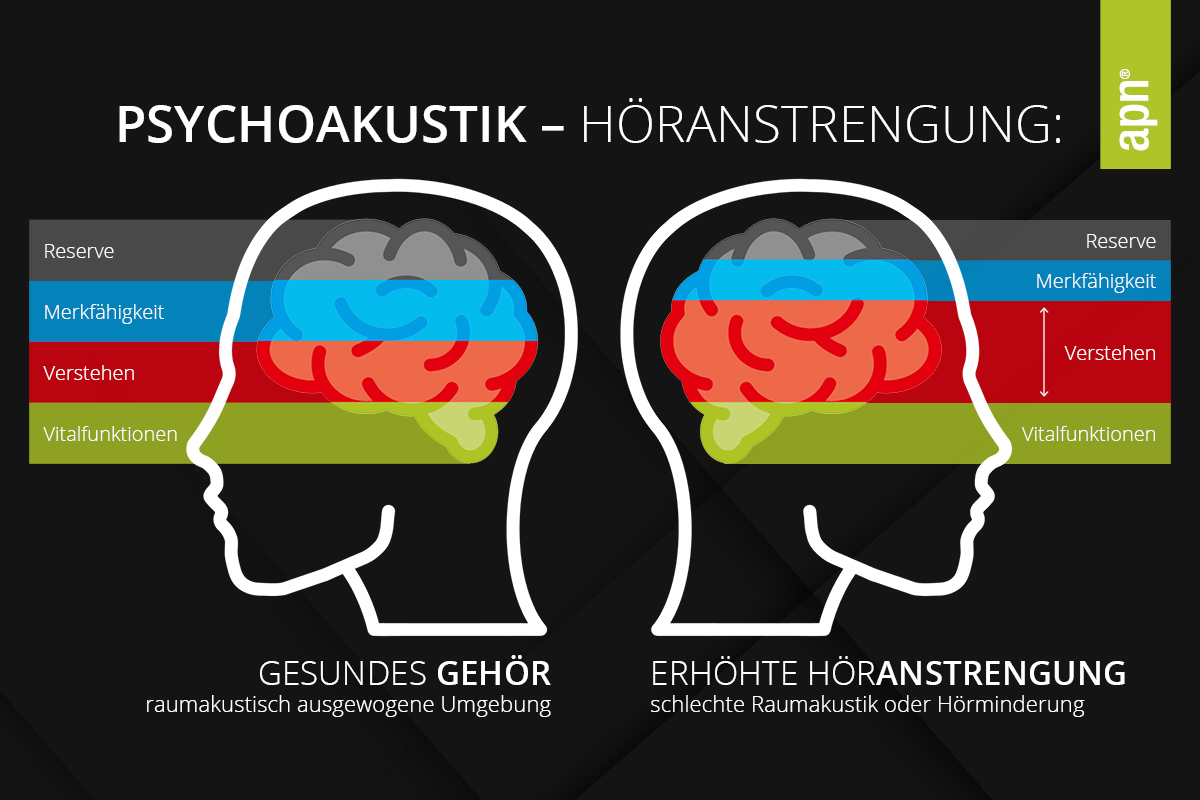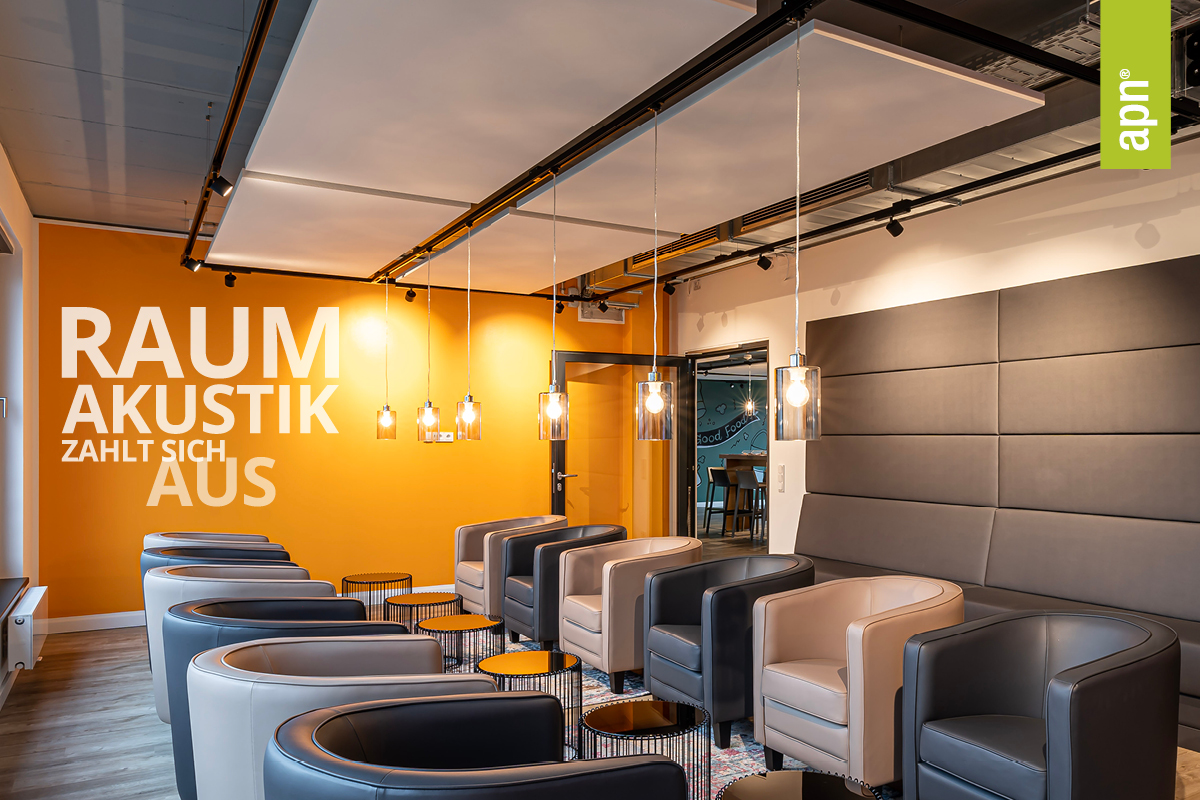Acoustics? We do that with movable walls!
The underestimated importance of room acoustics – Part 4
“A few partitions are enough to improve the acoustics.” You often hear this sentence when it comes to optimizing room acoustics. There are numerous suppliers of movable walls on the internet and your trusted office furniture store also has a whole range of them on offer. Partitions can be useful for creating zones and providing visual screening, as visual distractions can also disrupt concentration. But from an acoustic point of view, partitions alone are not enough. This is a very simplistic approach and does not do justice to the complex issue of room acoustics.
Diverse sound sources in the office
There are many sources of noise in an office: Conversations, telephone noises, keyboard clatter and other sounds. In addition, the sound sources move and change as we move around the room and don’t sit still at our desk. For example, we go to our colleagues to discuss something. The next moment, a phone call is being made in another corner of the room. Walking routes are sometimes more and sometimes less frequented. Partitions alone cannot fully cover these diverse and dynamic sound sources.
Subjective perception of room acoustics
Above all, room acoustics are one thing: subjective. Hearing is a sense that we cannot switch off; everyone finds sounds and conversations more or less disturbing. What is pleasant for one person may be disturbing for another. Room acoustics are therefore a decisive factor in our well-being and are not only judged by pure measured values, but are a combination of many factors. If we feel very comfortable in a room, we will behave accordingly. It is therefore important to carry out comprehensive acoustic planning that takes into account the needs of all users.
Influence of room geometry and materials
The room geometry and the materials used also have a major influence on the acoustics in the room. Particularly in modern concrete buildings with hard floors and large window fronts, partition walls alone cannot compensate for the reflective surfaces. In addition, the requirements vary greatly depending on the intended use.
Sound propagation in detail
Let’s take a closer look at sound propagation: sound travels in three dimensions and can bend around obstacles and penetrate through materials. Although partitions can block direct sound between two points, they do not prevent sound from propagating along other paths. In offices, speech is the biggest source of distraction. This is why we focus our attention in room acoustics on the frequency ranges relevant to speech. Speech sound does not propagate linearly, but spherically from the speaker. This means that the sound is reflected first from the ceiling – the largest reflective surface in the room. Speech sound is also reflected from the walls and from reverberant furniture or obstacles. Sound therefore spreads in three dimensions and must therefore also be captured in three dimensions.
Measures to improve the room acoustics
In order to capture the three-dimensional propagation of sound, we need balanced basic damping across the ceiling and walls. Room division measures create acoustic boundaries and zoning. Partitions and table tops are ideal for attenuating sound directly at the workplace. The right height is particularly important here.
In ISO 22955, various measurement set-ups for room acoustic measures were tested and the best results for a balanced acoustic atmosphere were achieved with three-dimensional occupancy. This means: with measures on the ceiling, the wall and the room. It should be noted that this is not about full-surface coverage, but about targeted measures that result in a harmonious mixture of attenuation, diffusivity and shielding. For example, ceiling absorbers and corresponding shielding and zoning elements are installed above the workstation, with additional wall elements at ear height for workstations close to walls. However, over-attenuation should be avoided at all costs. We reported on an illustrative example in Part 2 of this series of articles.
In smaller offices, room partitioning measures play a lesser role, with the ceiling and walls taking center stage. Wall coverings are particularly important in narrow rooms, as otherwise horizontal sound fields create an annoying flutter echo.
Conclusion: Holistic three-dimensional acoustic planning
The topic is complex and must be considered as such for an optimal result. Partition walls alone are too one-dimensional and cannot acoustically optimize the room acoustics in their complexity. Half-hearted planning can therefore lead to expensive revitalization costs. Holistic acoustic planning includes not only movable walls, but also other measures such as ceiling sails, baffles, wall absorbers, special room partitioning elements, screening or curtains. These products can help to absorb sound or provide diffusion, creating a more pleasant and productive working environment. It is important to consider the specific requirements and circumstances of each room and develop a customized solution.
Partitions can be part of the solution, but they cannot optimize a room acoustically as a whole, because due to
- Various sound sources
- Room geometry and materials
- Sound propagation
- human perception
…room acoustics require holistic planning.
We are happy to advise you – holistically, comprehensively and three-dimensionally.
New Work needs New Education
New Education and New Work: shaping the future together
The world of work is changing rapidly and the education system must also adapt to this change. “New Education” is the key to fully exploiting the opportunities of hybrid working and learning and forming a strong partnership with “New Work”. Now is the time to actively shape the future of education and work and seize the opportunities of this new era.
Why New Education?
“New Education” goes beyond traditional educational approaches and promotes the development of skills that are essential in the modern working world. These include digital skills, critical thinking and the ability to collaborate in (virtual) teams. These new educational approaches not only support professional development, but also lifelong learning, which is becoming increasingly important in a constantly changing world of work.
The synergy of New Education and New Work
“New Education” and “New Work” are not separate concepts, but complement each other. While “New Education” ensures that learners acquire the necessary skills and knowledge to be successful in the new world of work, “New Work” promotes flexible working models and a healthy work-life balance. Together, they create a working and learning environment that is not only efficient, but also sustainable and fulfilling.
Actively shaping the future
It is up to us to actively shape the future of education and work. By integrating the principles of “New Education” and “New Work” into our everyday lives, we can promote a culture of continuous learning and innovation. Let’s seize the opportunities of this new era to create a better, more flexible and inclusive world of work.
Acoustics in existing buildings: an underestimated potential
The underestimated importance of room acoustics – Part 3
“Acoustics in existing buildings? You can forget it!” When it comes to acoustic design in existing buildings, you often hear this provocative statement. In the previous article, we highlighted the enormous benefits of early planning. One might even think that this would support the statement “no acoustic concept can be implemented in existing buildings”. But the opposite is the case: existing spaces in particular offer excellent opportunities for acoustic optimization measures. This is because the topic is already becoming increasingly relevant and will continue to do so in the future.
The relevance of revitalization
When we talk about construction in existing buildings, it’s not just about sustainability and conserving resources when renovating buildings. Rather, the focus is on revitalizing spaces. The aim is to breathe new life into old buildings and transform them into modern, functional working environments. The average useful life of office space today is around three years. This means that constant change is taking place: Restructuring, new land use and innovative design approaches are the order of the day. Which presents us with new challenges.
Holistic planning is required
In this context, good planning is crucial. Early planning should not be equated with “building from scratch”. The main focus is on analyzing and defining usage requirements. The different areas such as space planning, functionality, digitalization, interior design, design and acoustics must flow into one another. Every room has different acoustic requirements due to its geometry and the materials used. These need to be worked out in order to plan flexible acoustic measures that can be integrated into a new space concept even after three years. We can respond to the given room geometry and architectural structure, as we find them in an existing building, and take them into account individually in our planning. Because we, from apn® accept the challenge and want to revolutionize acoustics in existing buildings.
Influence of design on well-being
The design has a considerable influence on user behavior and the well-being of employees. For example, quiet workstations can have a positive influence on the behavior of colleagues through a harmonious, calming design. It is an interplay of subjective perception, well-being and measurable room acoustics. In workshop areas, a lively design can stimulate inspiration and communication. Acoustic measures can also support your individual architectural style, create orientation and help employees to use spaces intuitively.
Conclusion: Acoustic concepts in existing buildings are possible and necessary
It is therefore possible to conceptually implement acoustics in existing buildings. This requires careful planning, know-how and the right choice of suitable materials and elements depending on the room type and usage characteristics. Let’s exploit the potential of existing spaces and transform them into acoustically optimized, modern working environments.
Holistic acoustics in existing buildings:
- Use the architectural structure – the architectural features form the basic structure and do not present any obstacles for an acoustic concept
- Flexible and modular system / adaptability – flexible and modular systems are required
- Acoustics know-how – understanding rooms and planning acoustics holistically and three-dimensionally
- Individuality of space concepts – every room is different: there is no “one fits all” concept, especially in existing buildings
How we make rooms speak
Rooms are more than just physical places – they tell stories.
Every room, every story comes to life through its colors, textures and materials.
They embody the emotions, the experiences and the character that the room radiates.
But what really brings these stories to life?
It is the room acoustics – the invisible element that shapes the atmosphere of a room.
It enables us to immerse ourselves in the story that the room conveys.
It is the connecting element that brings everything together and offers us a holistic experience.
The design of a room goes far beyond what the eye can see.
It’s about creating an experience that appeals to all the senses.
With us at your side as experts in room acoustics, we can work together to design spaces that not only tell stories, but also bring them to life.
Feel free to contact us to find out more.
We can also do acoustics later!
The underestimated importance of room acoustics – Part 2
“We can also do acoustics later!” – We at apn® acoustic solutions are often only called into a project as “problem solvers” when the acoustic problem is already obvious. The new premises are already in use and suddenly the acoustic problem becomes apparent. The employees are frustrated because it is too loud. “I can’t concentrate, I want to go back to the individual office…”
In the best-case scenario, the acoustics have not even been considered; in the worst-case scenario, acoustic measures have already been implemented that do not match the employees’ requirements or tasks. This is “suboptimal” for many reasons. First of all, the problem needs to be solved quickly, which often entails expensive revitalization measures. In addition, employees are already dissatisfied and frustration with the “new” office space is constantly growing.
If no acoustic concept is available, we develop a customized concept that is tailored to the specific office situation. There are numerous ways to influence existing buildings. If acoustic measures already exist, we try to optimize the situation by adding and implementing suitable measures. Elements that were purchased out of ignorance need to be rearranged, replaced, supplemented or readjusted.
An acoustic disaster in the new office complex
An illustrative, albeit sad, example of poor acoustic planning can be seen in a newly refurbished office complex. The employees complained about the acoustics, even though it was a modern new building with open-plan offices and high-quality furnishings. The architect had recognized the importance of acoustics and installed a high-performance absorbing ceiling. Great importance was attached to quiet ventilation and insulating windows. All around, a lot was done to create a quiet environment. But despite these measures, considerable acoustic problems arose.
Our acoustician carried out numerous measurements and determined a speech intelligibility of over 21 meters. The room geometry favored horizontal sound fields in combination with overdamped acoustics. This meant that every conversation, every phone call and even the faintest keyboard clatter could be clearly heard throughout the office. To give you a rough idea of this figure, although it is not an exact value: Our voice spreads out in a spherical shape and carries about 9 meters in free field, without the influence of absorption or reflection. In open-plan offices and especially in modern working environments where different teams work together, the aim is to achieve speech intelligibility of around 5 meters. This guideline value comes from the new ISO 22955, which allows teams working together to communicate well while other teams are not unnecessarily distracted.
VDI 2569 establishes a link between the intelligibility of speech (expressed by the speech transmission index, STI) and our cognitive performance. Studies have shown that with an STI value above 0.5, our short-term memory is strongly influenced by irrelevant speech. This has a negative impact on our ability to concentrate. To create a good acoustic office environment, the STI value below 0.5 should be minimized to 5 meters. In this way, the negative influences of irrelevant speech are dissolved and we are able to concentrate better.
To achieve this, diffusivity is required above all so that the irrelevant speech is transmitted diffusely and disappears in the background noise. In our example, however, the speech transmission was now more than 21 meters. This means that every word spoken by colleagues at the other end of the office could be heard – an absolute nightmare for the employees.
Optimization measures in the office: a balancing act between costs and sustainability
We took various measures to improve the acoustics in a newly refurbished office complex. The simplest solution would have been to remove the ceiling completely and refurnish the room in a targeted and three-dimensional manner. This would not only have meant temporarily closing down the space, but would also have been anything but resource-efficient. Not to mention the additional high conversion costs that would have been incurred.
Instead, we opted for a different optimization measure. Supporting elements were installed on the walls to minimize horizontal sound fields and a sound masking system was introduced. This creates an artificial background noise and masks speech. We have therefore solved the acoustic problem here.
Well-intentioned acoustic planning resulted in additional revitalization measures and the project costs increased considerably.
You might think that all is well now. Unfortunately, however, another phenomenon has emerged that is having a significant impact on the company: Employees have lost confidence in the new workspaces due to the poor acoustics and the resulting frustration. This leads to a drop in motivation and productivity and therefore has a negative impact on the entire corporate culture.
Frustration and disappointment: the challenges of poor acoustics in the office
A considerable amount of frustration has built up among the employees in this newly furnished office complex. They had to experience the negative effects of a poor acoustic environment. Psychologically speaking, the open-plan area is now “scorched earth”. Statements such as “It was clear that it wouldn’t work. We knew that beforehand. Open-plan areas don’t work” are widespread.
The positive effect that this new office space should normally bring – new motivation, inspiration and lively communication – does not materialize. It will therefore be a major challenge for the company and managers to get these employees back on board. Breaking down the existing barriers and turning the project into a success will require a lot of work and commitment.
Lessons learned from an acoustic misstep: the importance of early planning
What can we learn from this example? Early integration of room acoustics issues is essential. Seek advice from practical experts. Although the office space in our example was mathematically well equipped, the actual requirements were not taken into account. With sound acoustic know-how, such hurdles and stumbling blocks can be avoided in advance.
When we are called to a project, we first get to know our customers. Who is working here? Who will be working here? What do the activities and routes look like? This information helps us to optimize the acoustic concept. Many things can be solved by zoning and defining the room usage characteristics.
Good acoustics in the office are crucial for the well-being and productivity of employees. “We can do acoustics later!”, perhaps. But by involving employees at an early stage and tailoring the acoustics to their needs, expensive revitalization measures can be avoided and the associated added value fully exploited.
Acoustics is more than just an optimal listening experience. Acoustics is an interplay of many details and facets such as room geometry, activity, use of space, furniture and interior.
The advantages of early planning are
- Cost efficiency: savings on expensive revitalization measures, fewer days of absence, cost-effectiveness thanks to holistic space concepts
- Acceptance of the space: Benevolent acceptance of the working environment, psychological added value increases the success of new space and change management concepts
- Appreciation for employees: Increased satisfaction and motivation, the feel-good factor increases enormously, fluctuation decreases
- Optimal acoustic solution: Individual concepts tailored to the room and its usage characteristics as well as to the company itself
Acoustics are far too expensive!
The underestimated importance of room acoustics – Part 1
Statements such as “Acoustics are far too expensive!” or “Acoustic measures are not worth it.” we’ve probably all heard them before. But why are room acoustics a topic that deserves attention at all?
There is an opinion that room acoustics are not so important and that a loud colleague should simply leave the room to make a phone call. The solution seems simple: If everyone sticks to the office rules, there will be no problems. However, the reality is much more complex.
The power of hearing: how room acoustics influence our health and productivity
Hearing is a sense that we cannot switch off. For evolutionary reasons, our hearing protects us from danger. A loud bang immediately puts us on alert and our body goes into “fight or flight” mode. So it’s no wonder that our stress hormones react sensitively to sounds. A constantly noisy environment increases stress hormone levels and can damage our health in the long term. As our brain is constantly processing environmental sounds and assessing them for danger, this auditory strain impairs our cognitive performance. Studies have even shown that poor room acoustics can lead to cardiac arrhythmia.
In addition to the health aspects, a high or restless noise level at the workplace is disturbing and makes us feel uncomfortable. A look at psychoacoustics can help here. Our concept developer Acoustics has provided us with a graphic that shows how listening effort strains our brain. The schematic diagram shows the cognitive performance distribution of a person with normal hearing under optimal conditions in contrast to the cognitive performance distribution of someone who has difficulty understanding. This may be due to a hearing impairment, a foreign language or poor room acoustics. Under optimal conditions, we understand more easily, learn better and can concentrate better. Our brain has more reserves, we are more relaxed and efficient.
The OFFICE ROXX reader survey “Room acoustics 2023” commissioned by the “Quiet please!” acoustics campaign shows that office workers find conversations and phone calls from colleagues particularly distracting. This underlines the fact that room acoustics are more important than you might think. Good room acoustics not only ensure better health for employees, but also fewer days of absence, longer periods of concentration and reduced errors at work. This means that the effectiveness and therefore the performance of the company increases.
How can room acoustics be measured?
Room acoustics are mainly measured using the reverberation time, i.e. the time it takes for a sound event to decay in a room. Roughly speaking, this time describes the reverberation of a room. In offices, this time should be significantly less than one second1. The geometry of the room, the nature of the surfaces and the furniture play a decisive role here. In addition to the reverberation time, speech propagation and speech intelligibility are also of decisive importance. There are also very different acoustic requirements depending on the use of the room and the activities. For example, a lecture room requires different acoustic conditions than an open-plan office. In the lecture room, the aim is to improve speech intelligibility and speech transmission. In an open-plan office, however, speech should not be carried throughout the room.
Standards, guidelines and calculation bases help us to plan and calculate optimum acoustic equipment. However, practice shows that numbers alone do not do justice to room acoustics. There is more to it than pure mathematics. There are many individual factors that interact and work together. It is therefore advisable to seek advice, because the fact is:
Eine optimale raumakustische Umgebung sorgt für
1. optimal speech intelligibility: improved communication, easier to follow conversations – more capacity for memory and reserves.
2. increased work performance: better concentration leads to fewer errors, more effective work and improved performance.
3. reduces stress and fatigue: fewer days off and more relaxed evenings.
4. greater well-being: The room is perceived as more pleasant – we feel more comfortable and can work more productively. This shows appreciation for the employees.
“Acoustics are far too expensive!” – Room acoustics are a worthwhile investment: for the health of employees, their productivity and ultimately for the success of a company!
- This is a simplified specification and does not reflect the complex interrelationships of room acoustics. More details and connections will follow in further articles). ↩︎
